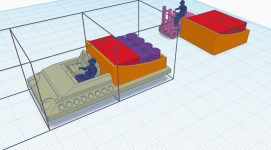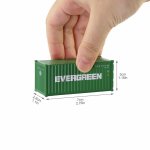I think all the 15mm minis look better on 15mm grids. When drawing up ship or building plans I get the cheap poster board at Dollar Tree and draw them to 15mm scale.The thing is that most modern "15mm" figures are actually 1:100 scale (6' human is 18mm tall); it's the older ranges (the '80s Traveller miniatures, early GZG ranges, etc) are closer to 1:120 scale (6' human is 15mm tall). I seem to recall that the original grids for use with 15mm figures were 1.5m = 0.5" (roughly 1:120).
If using the taller modern "15mm" (1:100 scale) figures, you'd want to be using a 15mm grid.
You are using an out of date browser. It may not display this or other websites correctly.
You should upgrade or use an alternative browser.
You should upgrade or use an alternative browser.
Ok, on cargo and pallets... In 15mm
- Thread starter infojunky
- Start date
infojunky
SOC-14 1K
Me too....I think all the 15mm minis look better on 15mm grids. When drawing up ship or building plans I get the cheap poster board at Dollar Tree and draw them to 15mm scale.
infojunky
SOC-14 1K
The 15mm miniature would be a 5ft man, and the 18mm miniature would be a 5'10 man.
Quick note the standard for 15mm is 15mm to the eyes, just like napoleonics figures. So in general 17 t0 18mm tall.
Also note 15mm's nominal scale of 1/100th is due to sighting models where in that scale, and 15mm figures visually worked well with them.
As for intermodal containers there is a bunch of discussion about on these forums.
I purposely chose to work with Air Cargo standards in this thread, in that for smaller craft you are more likely to be using some flavor of palletized cargo rather than full containers, Especially when doing cargo transfer through pressurized docking arraignments.
Though note your standard Master pallet and/or ULDs will generally fit into standard intermodal containers.
Quick note the standard for 15mm is 15mm to the eyes, just like napoleonics figures. So in general 17 t0 18mm tall.
"eye height" measurement has several problems, chief among them is that not all "15 mm" minis are the same proportion, and therefore not the same height. At 1:100 These two "15 mm" figures would give you either a 5'3" man or a 5'5 man. Which is probably not the look most players are going for. To get an average height man you'd be looking for a miniature closer to 16 mm "eye height". And to get a "heroic" 6'4 man you need a "17 mm" mini.
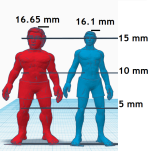
Master air pallets were standardized in the early 60s at 108"x88". Later when commercial freight developed their standards they kept the 88" length, but widened the pallets, and containers to 125" to fit the fuselage width of the DC-8 and 707. Resulting in the 125"x88" "A" pallet. The military pallet became the "B" pallet at 108"x88". Later when aircraft got even wider the pallets grew to 96" by 125, or the "M" base. So those are your three basic aircraft pallet, and container sizes. Height is another consideration, the military uses a 90" and a 60" standard cube, the "ISU" which I think, height wise would suit Traveller better, 2 stacked would be the height of a deck plan square.As for intermodal containers there is a bunch of discussion about on these forums.
I purposely chose to work with Air Cargo standards in this thread, in that for smaller craft you are more likely to be using some flavor of palletized cargo rather than full containers, Especially when doing cargo transfer through pressurized docking arraignments.
Though note your standard Master pallet and/or ULDs will generally fit into standard intermodal containers.
.
The big consideration is that the ships in Traveller a going to be larger than a cargo airplane. A far trader is going to have 60-80 dTons of cargo capacity, compare with ~50 dTons for a 747 or ~40 for a 777. For a 747 that's 40 cargo containers, for a Far trader that'd be closer to 60. If you go with intermodals you'd get that down to 20 for 20' containers, and 10 for 40 foot containers, which is a manage able amount of minis.
It's worth noting that much of Boeing's development of the 747 was taken from a proposed military transport, for a contract that Lockheed won. Their winning design? The C-5 Galaxy.The big consideration is that the ships in Traveller a going to be larger than a cargo airplane. A far trader is going to have 60-80 dTons of cargo capacity, compare with ~50 dTons for a 747 or ~40 for a 777. For a 747 that's 40 cargo containers, for a Far trader that'd be closer to 60. If you go with intermodals you'd get that down to 20 for 20' containers, and 10 for 40 foot containers, which is a manage able amount of minis.
infojunky
SOC-14 1K
"eye height" measurement has several problems, chief among them is that not all "15 mm" minis are the same proportion, and therefore not the same height. At 1:100 These two "15 mm" figures would give you either a 5'3" man or a 5'5 man. Which is probably not the look most players are going for. To get an average height man you'd be looking for a miniature closer to 16 mm "eye height". And to get a "heroic" 6'4 man you need a "17 mm" mini.
Dude, Ok...
Some history on the niche of a niche that is 15mm SF. Geeze, nearly 30 years ago there were no new 15mmSF figures being produced. Couple that there was only a couple of companies producing legacy figures (Note the 25mm figures where just plain dead at that point as well). A group of us were talking on the venerable horribly flawed Miniatures Page about the lack of figures in any scale. I noticed that Ground Zero Games was still producing, as was what was to become the current Alternative Armies had their legacy 15mm available, and the classic Citadel/RAFM figs were generally cheap on eBay. I preposed we buy what figures that were available, and lobby the manufactures to produce new figures. Related we established a standard we were looking for, and what was common in the large area of not science fiction 15mm, those the general 15mm to the eye became the standard we asked for.
Also, 15mm only has a nominal scale, not a true scale. Think of Hot Wheels or Matchbox the size is kinda the standard. With all of this there is plenty of room for some variation around the standard. But since the market and production base is so small the request for a general standard isn't out of line.
The final rule is what looks good visually on your table is ok.
infojunky
SOC-14 1K
Master air pallets were standardized in the early 60s at 108"x88". Later when commercial freight developed their standards they kept the 88" length, but widened the pallets, and containers to 125" to fit the fuselage width of the DC-8 and 707. Resulting in the 125"x88" "A" pallet. The military pallet became the "B" pallet at 108"x88". Later when aircraft got even wider the pallets grew to 96" by 125, or the "M" base. So those are your three basic aircraft pallet, and container sizes. Height is another consideration, the military uses a 90" and a 60" standard cube, the "ISU" which I think, height wise would suit Traveller better, 2 stacked would be the height of a deck plan square.
Ok, I point at a thing then put it into easily model able measurements and materials... See my posted pictures above.
.
The big consideration is that the ships in Traveller a going to be larger than a cargo airplane. A far trader is going to have 60-80 dTons of cargo capacity, compare with ~50 dTons for a 747 or ~40 for a 777. For a 747 that's 40 cargo containers, for a Far trader that'd be closer to 60. If you go with intermodals you'd get that down to 20 for 20' containers, and 10 for 40 foot containers, which is a manage able amount of minis.
Somewhat, and I didn't discount Intermodal containers, I just didn't address them in this thread. This is about cargo that can be handled easily in a shirt-sleeve environment, hence ULD's and the like.
A further note, consider UNREPs, 4 pallets at a time is about the biggest load on the Highline generally. Couple that very few of the traditional Smallcraft have problems with a intermodal container.
"The final rule is what looks good visually on your table is ok."
Used to run into this in wargaming. A 1/300 scale vehicle looks small next to the same vehicle in 1/285 on the same table. But if you use some 1/300 minis without the same type of 1/285 on the same table you can kind of, get by with it.
Used to run into this in wargaming. A 1/300 scale vehicle looks small next to the same vehicle in 1/285 on the same table. But if you use some 1/300 minis without the same type of 1/285 on the same table you can kind of, get by with it.
infojunky
SOC-14 1K
In the 15mm circles it isn't uncommon to wander down the toy aisle with a representative figure in hand comparing it to possible useful toys."The final rule is what looks good visually on your table is ok."
Used to run into this in wargaming. A 1/300 scale vehicle looks small next to the same vehicle in 1/285 on the same table. But if you use some 1/300 minis without the same type of 1/285 on the same table you can kind of, get by with it.
A 463 or ISU is easy to model, but it is not the best fit in the 1 dTon unit that ships are modeled in, and pallets don't fit neatly on them either. They are too short in one direction, and too long in the other.Ok, I point at a thing then put it into easily model able measurements and materials... See my posted pictures above.
Somewhat, and I didn't discount Intermodal containers, I just didn't address them in this thread. This is about cargo that can be handled easily in a shirt-sleeve environment, hence ULD's and the like.
A further note, consider UNREPs, 4 pallets at a time is about the biggest load on the Highline generally. Couple that very few of the traditional Smallcraft have problems with a intermodal container.
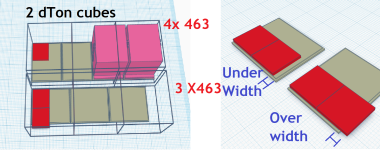
I think a 12mm X 12mm pallet would be good, it is correctly sized for a 1:100 model of real world 48" X 48" pallet and It fits 4 55 gallon drums neatly, which model at 5.8mm diameter. From that you can arrive at a 25.5mm x 25.5mm square pallet, which will fit in a 29 x 29 mm intermodal.
The intermodal holds 28 crates that are 12mm cubes, and fills 6 dTons.
The drum, pallets, and crate are very easy to model if you want individual pieces for warehouse handing.
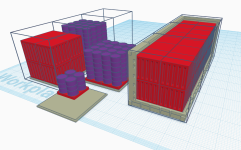
infojunky
SOC-14 1K
A 463 or ISU is easy to model, but it is not the best fit in the 1 dTon unit that ships are modeled in, and pallets don't fit neatly on them either. They are too short in one direction, and too long in the other.
Dude, try this for fast modeling of a Intermodal container in 15mm.
Take two 1 inch wood cubes, glue them together. Slap some plastic card for texture on 5 of the 6 faces for texture. Add as much detail as you feel necessary. You are now in the ballpark.
Note I generally am lazy and use HO scale Containers mostly. Unpainted ones from Ahern are really cheep.
BlackBat242
SOC-14 1K
It's worth noting that much of Boeing's development of the 747 was taken from a proposed military transport, for a contract that Lockheed won. Their winning design? The C-5 Galaxy.
Here is the Boeing design... note that it is ~17' shorter and ~7' less wingspan than the Lockheed entry. The Boeing also had the nose swing open to the side, while Lockheed's swings upwards.
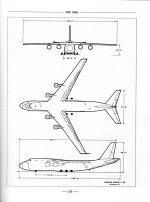
HO scale inermodals are suprisingly close to what would be a 6 dTon intermodal. about 1 mm wider, 1 mm shorter, and 4 mm longer and they'd be dead on.Dude, try this for fast modeling of a Intermodal container in 15mm.
Take two 1 inch wood cubes, glue them together. Slap some plastic card for texture on 5 of the 6 faces for texture. Add as much detail as you feel necessary. You are now in the ballpark.
Note I generally am lazy and use HO scale Containers mostly. Unpainted ones from Ahern are really cheep.
Attachments
infojunky
SOC-14 1K
Yep, I have a metric butt-load of them. Somewhere... Honestly My Pile is HUGE...HO scale inermodals are suprisingly close to what would be a 6 dTon intermodal. about 1 mm wider, 1 mm shorter, and 4 mm longer and they'd be dead on.
Apologies as this is my first inquiry into the issue physical representation of cargo in a hold.I'm a little late to the party here, but that won't stop me from throwing in my 2¢.
.
If Traveller assumes 1.5 m squares represented by a 15mm grid then 1:100 is a good fit, but when it comes to scales there is a little sillyness.
The real sticking point is that most miniatures assume assume a 6' (or so) man, while most games assume a 5' (or so) game grid. Even Traveller, which uses 1.5 meter {59 in, or 4.91 feet} squares. So the 15mm tall miniature man is at closer to 1:120, while the game grid is at 1:100.
.
Fortunately we live in the modern age of 3D printing and STL files, so you can scale your terrain and miniatures as suits you. For 1:100 or a 1.5m game grid at 15mm or .59" you can snag any number of miniatures and terrain and scale them to fit. A 6' man would be 18.28 mm tall at this height. 3D slicing software lets you scale STL files either by percent, or to a specific dimension. So if you grab some shipping container files from somewhere you can scale them to be ~60 mm or 120mm long depending on if it's a 20 or 40 foot container.
.
The real issue is that real world, interalmodal shipping containers don't conform exactly to Traveller's 1.5m x 1.5m x 3.0m standard grid. the length is good, 6.058m or 12.192m the width is odd at 2.438m and the standard height is either off, at 2.59m or close at 2.89m. Out of the 3 dimensions width is the real problem child. Stretching a standard 20' container file 20% in width and 10% in height gives a 2.9m x 2.9m X 6m cube, which fits nicely with Traveller's grid, and gives a nice 4 dTon unit of cargo.
The 15mm miniature would be a 5ft man, and the 18mm miniature would be a 5'10 man.
View attachment 4226
Q. How high is the ceiling in a hold, I am assuming at least 3m given the above measurements?
Q. Isn’t the 1.5m m3 the standard for 1DTon calcualation?
Q. Given the above measurements for 15mm, I could best / easiest represent a standard container with a block measuring 2.5m (1.5 grid) X 2.5m (1.5 grid) X 6m (4 grid)?
Okay, have how seen the second page and all questions answered.Apologies as this is my first inquiry into the issue physical representation of cargo in a hold.
Q. How high is the ceiling in a hold, I am assuming at least 3m given the above measurements?
Q. Isn’t the 1.5m m3 the standard for 1DTon calcualation?
Q. Given the above measurements for 15mm, I could best / easiest represent a standard container with a block measuring 2.5m (1.5 grid) X 2.5m (1.5 grid) X 6m (4 grid)?
Similar threads
- Replies
- 7
- Views
- 1K
- Replies
- 8
- Views
- 4K
- Replies
- 0
- Views
- 2K

